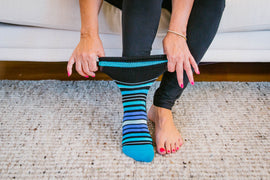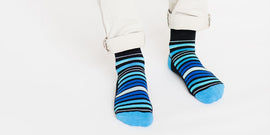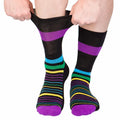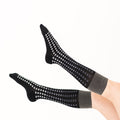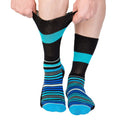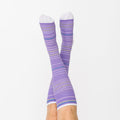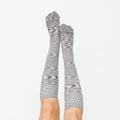What Kind of Chips Can Diabetics Eat?
Posted by SIMON LIM

When you have diabetes, it's hard to eat chips. You want to enjoy them, but they're loaded with carbs and calories. They're not exactly the healthiest snack food around. But don't worry! We've got you covered with this quick guide to the alternatives if you're diabetic and want to enjoy some crunch.
Why Do Diabetics Need To Watch Out When Eating Chips?
Diabetics should be aware that chips are high in calories and have a high glycemic index. Typical potato chips have a glycemic index of 70.
A glycemic index is a number that indicates how much your blood glucose levels will increase after eating a particular food. The higher this number is, the more likely you will experience an increase in your blood glucose levels.
Because of this, people with diabetes are often advised to eat foods with a low glycemic index. This will help them keep their blood glucose levels from rising rapidly and causing problems with their diabetes management plan or weight loss goals.
Downsides of Eating Chips for Diabetics
What makes chips dangerous for diabetics? Here's a rundown of unhealthy ingredients that chips contain:
Calories and Fat: Chips are high in fat, which means they contain more calories than most other foods. Chips can cause blood glucose to shoot up if you overeat them in one sitting.
Additionally, eating too many chips over time can cause weight gain and increase your risk of developing heart disease or other problems related to obesity.
Sodium: Consuming too much salt can make it more difficult to control diabetes. Plus, the additional sodium is a problem for those with high blood pressure or heart issues.
You should try to keep your daily sodium intake under 2,000 mg per day, but one serving of chips can contain as much as 500 mg. That's not even including any seasoning!
Types of Chips for Diabetics
Want to know what kinds of chips are safe to eat if you have diabetes? This brief guide will help you make the right choices at the chip aisle.
Potato Chips: Potato chips are often made with sugar and corn syrup, so they're not ideal for diabetics. But if you must have them, check the ingredients list to find options that use no sugar or corn syrup.
Tortilla Chips: Tortilla chips are usually made from corn, but some brands also contain wheat flour. Look for tortilla chips labeled "wheat-free" or "gluten-free."
Corn Chips: Corn chips are made from corn, which is naturally low in carbs and calories. It's just the added salt and fat that make them unhealthy for diabetics. If you want to eat corn chips, choose ones with no more than three grams of fat per serving.
Vegetable chips: These are another excellent option for people with diabetes who want something crunchy and salty. It has less fat and calorie content than regular potato chips. Just make sure you don't overdo it!
Fruit chips: Fruit chips are also an option if you want something sweet but to stay moderate on sugar or carbs. Just make sure they're made from real fruit, so you know what's going into your body!
Enjoying Chips, Guilt-free
Diabetics and chips: two things that don't always go together.
While delicious, chips are not exactly the best for a diabetes diet. They're high in fat and sodium, which can cause spikes in blood sugar levels. But don't worry. We've got you covered! We'll tell you what to look out for when eating chips as a diabetic so you can enjoy them guilt-free.
- Check the nutrition facts: Look at how many carbs are in each serving of chips and compare them against other options. If you're going to have a snack, make sure it's low in carbs so it won't affect your blood sugar levels too much.
- Check out the ingredients list: You want whole grains as your chip's first ingredient (and only ingredient). If more than two or three ingredients are listed, it's probably not what you're looking for. A simple label indicates that these chips will be healthier for you than their competitors' offerings.
- Find out what oil was used to make your chips: If it's not olive oil or coconut oil, it may contain unhealthy fats like hydrogenated oils or palm oil. These types of oil are not great for people with diabetes since they can raise blood sugar levels quickly after eating them!
- Pick baked over fried: Fried foods tend to have more fat and sodium than baked versions of the same food. If you want to stick with something healthy but still enjoy a treat from time to time, go with baked chips instead of fried ones.
- Choose whole grain varieties: Whole grains don't raise blood sugar levels as much as refined grains. If you're trying to keep your blood sugar levels under control while still enjoying a treat once in a while, then look for whole grain varieties such as oat bran or multigrain tortilla chips instead of white flour tortillas or regular corn chips (which are made mostly from corn meal).
- Make your own chips: If you're having trouble finding chips with low amounts of sodium and no artificial ingredients, consider making your own! There are plenty of recipes online that will get you started.
- Portion control: You can eat chips, but you have to manage your portions. The problem is that chips are super tempting and tasty so you might eat more than one serving at a time. Unfortunately, this can lead to weight gain and other health issues related to excessive calorie consumption.
To avoid these problems, here are some tips for portion control when choosing chips:
- Eat just one serving at a time. Choose a snack-size bag or packet rather than a large family-size bag or box of chips.
- Measure out your portion and put it in an airtight container before opening the bag or packet. You can also try using an actual measuring cup. This will allow you to see exactly how much food you have left after each meal, so there's no guesswork involved.
- Pair your chip snack with a healthy side dish such as fruit or yogurt instead of another salty food like cheese or crackers.
Takeaways
So, what kind of chips can diabetics eat? The best chips for diabetics are those that are low in calories and carbs and high in fiber. The good news is that there are plenty of options for diabetics who want to enjoy a tasty chip. By choosing the right brands, you'll be able to find a great-tasting chip that won't leave you feeling guilty about indulging!
SHARE:




